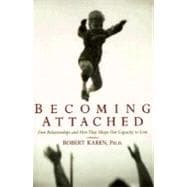
Note: Supplemental materials are not guaranteed with Rental or Used book purchases.
Purchase Benefits
What is included with this book?
| INTRODUCTION: How Do We Become Who We Are? | 1 | (12) | |||
| PART I. What Do Children Need? | 13 | (116) | |||
|
13 | (13) | |||
|
26 | (14) | |||
|
40 | (7) | |||
|
47 | (12) | |||
|
59 | (8) | |||
|
67 | (20) | |||
|
67 | (16) | |||
|
103 | (16) | |||
|
119 | (10) | |||
| PART II. Breakthrough: The Assessment of Parenting Style | 129 | (48) | |||
|
129 | (14) | |||
|
143 | (19) | |||
|
162 | (15) | |||
| PART III. The Fate of Early Attachments | 177 | (92) | |||
|
177 | (14) | |||
|
191 | (11) | |||
|
202 | (8) | |||
|
210 | (10) | |||
|
220 | (18) | |||
|
238 | (10) | |||
|
248 | (21) | |||
| PART IV. Give Parents a Break! Nature-Nurture Erupts Anew | 269 | (92) | |||
|
269 | (20) | |||
|
289 | (24) | |||
|
313 | (32) | |||
|
345 | (16) | |||
| PART V. The Legacy of Attachment in Adult Life | 361 | (50) | |||
|
361 | (18) | |||
|
379 | (15) | |||
|
394 | (17) | |||
| PART VI. The Odyssey of an Idea | 411 | (32) | |||
|
411 | (15) | |||
|
426 | (17) | |||
| APPENDIX: Typical Patterns of Secure and Anxious Attachment | 443 | (3) | |||
| ACKNOWLEDGMENTS | 446 | (3) | |||
| NOTES | 449 | (20) | |||
| BIBLIOGRAPHY | 469 | (18) | |||
| INDEX | 487 |
The New copy of this book will include any supplemental materials advertised. Please check the title of the book to determine if it should include any access cards, study guides, lab manuals, CDs, etc.
The Used, Rental and eBook copies of this book are not guaranteed to include any supplemental materials. Typically, only the book itself is included. This is true even if the title states it includes any access cards, study guides, lab manuals, CDs, etc.